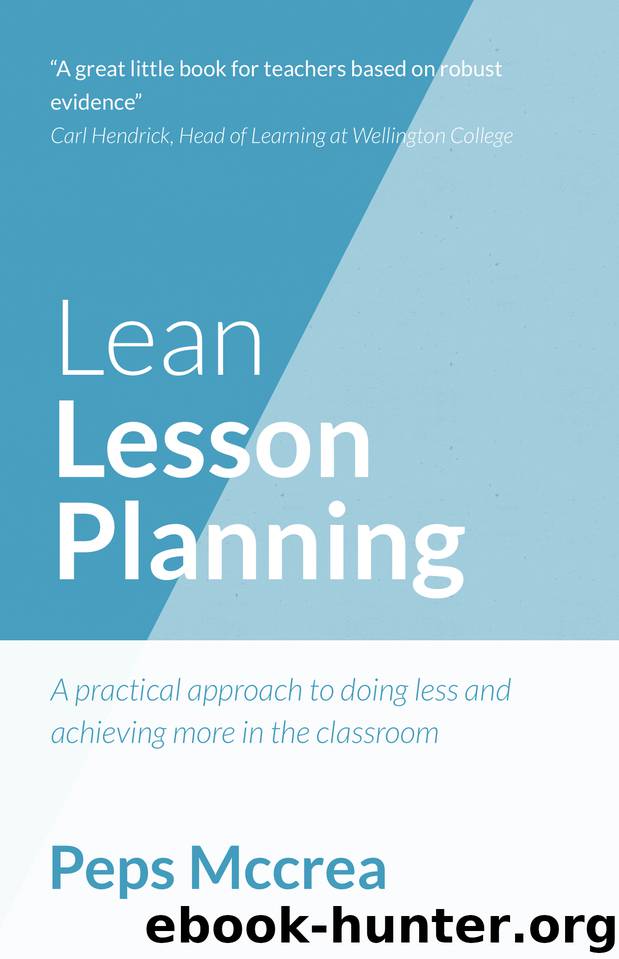Lean Lesson Planning: A practical approach to doing less and achieving more in the classroom (High Impact Teaching) by Mccrea Peps

Author:Mccrea, Peps
Language: eng
Format: epub
Published: 2016-11-15T16:00:00+00:00
Here are a couple of activity types that can achieve this without excessive preparation:
• Low floor, high ceiling One task that is accessible to all, but can be taken as far as each student is able. These are often open-ended, or investigational in nature.
• All start, no finish A series of questions graduated in difficulty so everyone can answer the first one, but no one can answer the last.
It's also important to be ready to adjust the level of challenge as needed during an activity. One easy way to do this is by adding or removing supports, such as hint cards, writing frameworks or calculators.
One strategy that you should use with care is that of letting your students move on early, answering the next page in the textbook (or equivalent). This can sometimes create more problems than it solves. Aim to extend deeper rather than faster.
Feedback baked in.
Of all the factors that can leverage impact, feedback is possibly the most powerful. In John Hattie's analysis, it has almost twice the effect of the average of all the other effects (8).
Lean activities bake in opportunities for feedback as standard (9).
This does not always need to be teacher-led. Well-structured peer feedback and self-assessment can be powerful too. Feedback is effective when it (10):
• Closes the gap between where students are and the next learning milestone.
• Focuses on how to help students move on, not on what went wrong.
• Is provided alongside multiple opportunities to put it into practice.
• Focuses on the single smallest thing that will help them make the most progress.
• Offers formative comments rather than marks.
Notes & further reading.
1. From How I plan: the triage goo.gl/3E6bP1
2. For more, see Chapter 8: Minimum Viable Lessons in The Thinking Teacher by Oliver Quinlan
3. See Teach Like a Champion 2.0 by Doug Lemov, p.147
4. From Visible Learning and the Science of How we Learn by John Hattie, p.48
5. For more, read Fewer instructions, better structures by Ewan McIntosh goo.gl/Adq0V
6. From Visible Learning and the Science of How we Learn by John Hattie, p.39
7. Based on Lev Vygotsky's Zone of Proximal Development
8. From Visible Learning for Teachers by John Hattie, p.130
9. For inspiration on how to put this into practice, see Moving from marking to feedback by Harry Fletcher-Wood goo.gl/y421mn
10. For a comprehensive overview, read Embedding Formative Assessment by Dylan William
Download
This site does not store any files on its server. We only index and link to content provided by other sites. Please contact the content providers to delete copyright contents if any and email us, we'll remove relevant links or contents immediately.
The Art of Coaching Workbook by Elena Aguilar(50990)
Trainspotting by Irvine Welsh(21520)
Twilight of the Idols With the Antichrist and Ecce Homo by Friedrich Nietzsche(18504)
Fangirl by Rainbow Rowell(9098)
Periodization Training for Sports by Tudor Bompa(8171)
Change Your Questions, Change Your Life by Marilee Adams(7637)
This Is How You Lose Her by Junot Diaz(6796)
Asking the Right Questions: A Guide to Critical Thinking by M. Neil Browne & Stuart M. Keeley(5649)
Grit by Angela Duckworth(5525)
Red Sparrow by Jason Matthews(5391)
Paper Towns by Green John(5092)
Room 212 by Kate Stewart(5040)
Ken Follett - World without end by Ken Follett(4646)
Housekeeping by Marilynne Robinson(4348)
The Sports Rules Book by Human Kinetics(4296)
Double Down (Diary of a Wimpy Kid Book 11) by Jeff Kinney(4208)
Papillon (English) by Henri Charrière(4199)
The Motorcycle Diaries by Ernesto Che Guevara(4016)
Exercise Technique Manual for Resistance Training by National Strength & Conditioning Association(3957)
